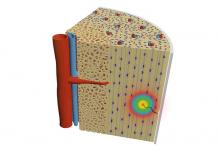The researcher Amir Abdollahi of the UPC’s Numerical Calculus Laboratory (LaCàn) participated in a study that found that flexoelectricity may be responsible for regenerating bone tissue damaged by microfractures.
Researchers at the Catalan Institute of Nanoscience and Nanotechnology (ICN2), a Severo Ochoa centre located on the campus of the Universitat Autònoma de Barcelona and a member of the Barcelona Institute of Science and Technology (BIST), have discovered that bone is flexoelectric, positing that flexoelectricity may have a role in the regeneration of bone tissue affected by the daily microfractures suffered by bones. This research has potential implications for the prosthetics industry and the development of biomimetic self-healing materials. The researchers Fabian Vasquez-Sancho, Amir Abdollahi, Dragan Damjanovic and Gustau Catalan (leader of the ICN2’s Oxide Nanophysics group) have published their work in the reference journal Advanced Materials.
Futher information: Press Room UPC


